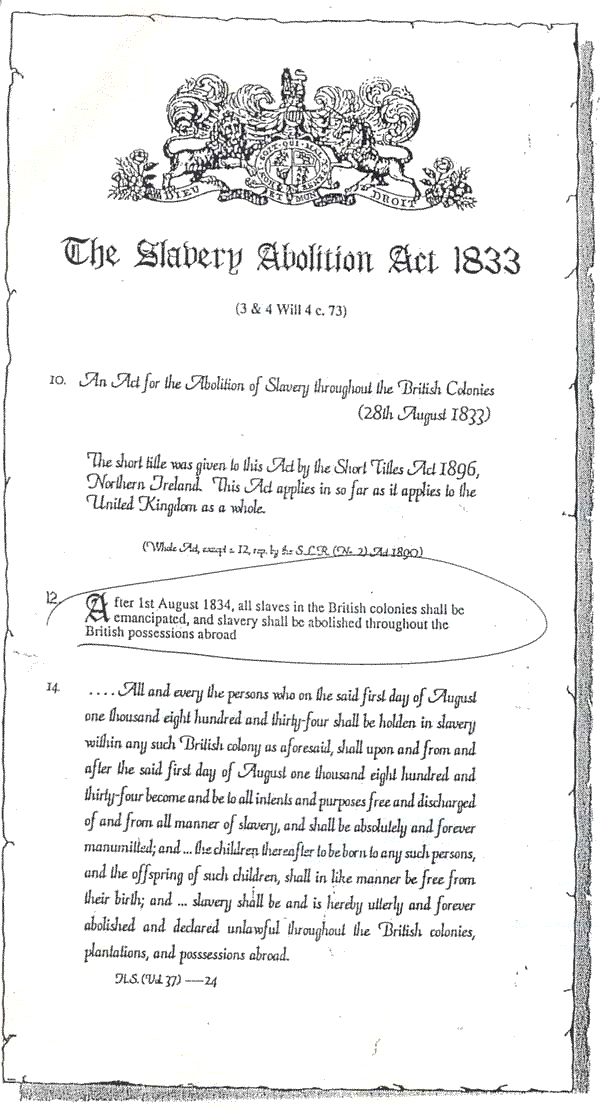Freed Slaves’ Craving For Education
 Newly emancipated blacks in Bermuda were so anxious for education — and so proficient at learning — the American Methodist Church considered establishing a school on the island to train Bermudians and US free men of colour to teach former slaves in the West Indies.
Newly emancipated blacks in Bermuda were so anxious for education — and so proficient at learning — the American Methodist Church considered establishing a school on the island to train Bermudians and US free men of colour to teach former slaves in the West Indies.
Slaves were freed in all British territories — including Bermuda — on August 1, 1834. A contemporary diarist described “a solemn quiet” falling across the island as former slaves “happily adjusted to their freedom and independence.”
By the end of that year a report in the 1834 volume of the “American Annals Of Education & Instruction” said Bermuda’s freed blacks were eagerly embracing the schooling now available to them.
The Wesleyan Methodist Connection — formed in 1843 at an organising conference in Utica, New York, by a group of ministers and laymen splitting from the Methodist Episcopal Church primarily over their objections to slavery — sent teachers to both Bermuda and the British West Indies to help school newly-emancipated blacks.
Technically Bermuda blacks had been forbidden to learn how to read and write during the days of slavery although this injunction was often obeyed “more in the breach than the observance” according to at least one early 19th century writer.
Unlike in the West Indian plantation colonies, Bermuda slaves had largely been absorbed into the island’s maritime-based economy in the 18th and 19th centuries — working as everything from shipwrights to sailors.
“During the past year, considerable effort has been made in behalf of the colored population of Bermuda,” said the American report on the Methodist missionaries active in Bermuda. “Mrs Holt, a highly respectable and benevolent lady, in a letter to a friend in the United States, has ably set forth the advantages which would result … from a permanent establishment at Bermuda, for the education of colored missionaries and teachers of the African race.
The 1833 Slavery Abolition Act Which Abolished The Institution In British Territories In 1834
“Mr Crofts, a Wesleyan missionary there, has also advocated, with much ability, the same plan, in a letter to Mr Cookman, of New Jersey. Mrs Holt is now training four or five persons for teachers. She thinks there is no time to be lost, and closes her remarks by saying, that ‘the West Indies need teachers instantly’; that after a small expense to purchase land and house to begin with, the students might easily pay their way at the Seminary, by manual labor; and that the only expense, annually required, would be to pay the salary of the Principal.
“Mrs H. also speaks of the very great anxiety manifested, both by parents and children, in Bermuda, for books, and refers to the success which has attended her efforts to establish a small library.
“This benevolent lady has also a school for the young in one of these islands, which she calls the Wilberforce School. The following is an extract from her letter: ’I teach the small colored boys from 6 to 8 in the morning; from 9 to 3, I attend to my own private school ; from 4 to 6 P. M. teach colored women and girls, at which time from 40 to 60 attend ; and from 7 to 9 in the evening, teach large boys and men.
“Last night, I formed a class of boys in Arithmetic, twenty-three in number. Never were any people more completely ready for instruction; and although we have been teaching only a fortright, already we see great improvement. We teach all to read, spell, write, and cipher.”
The report concluded by comparing the success of the Bermuda venture to the difficulties encountered by the only American school then educating free blacks: “We are exceedingly mortified to be compelled to say, that the first school for the colored population of our own free states, established a short time since in Canterbury, Connecticut, and which has met with constant opposition from the public sentiment, has, at last, been violently assailed, and the proprietors have thought it expedient to discontinue it, and sent the pupils — twenty in number — to their home; while in Bermuda, where more than half the population are colored, and where the most enlarged and liberal efforts have been made, and are still making for their education, the public peace and prosperity has never been greater, nor the state of society happier.”
African slaves arrived in the American colonies in 1619 on the same ship which had brought the first blacks to Bermuda.
Between 1776 and 1804, slavery was outlawed in every state north of the Ohio River and the Mason-Dixon Line but the institution was not finally abolished until the the 1861-65 Civil War between the northern states and the 11 slave-holding states which broke away to form the Confederate States of America.



Comments (1)
Trackback URL | Comments RSS Feed
Articles that link to this one: